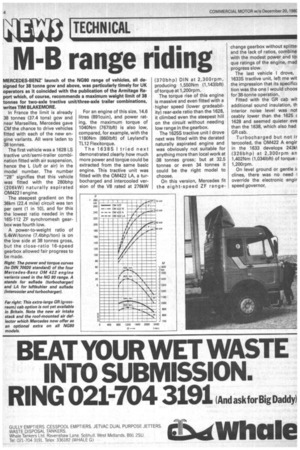IVI-13 range ridin
Page 16

If you've noticed an error in this article please click here to report it so we can fix it.
MERCEDES-BENZ' launch of the NG80 range of vehicles, all designed for 38 tonne gcw and above, was particularly timely for UK operators as it coincided with the publication of the Armitage Report which, of course, recommends a maximum weight limit of 38 tonnes for two-axle tractive unitithree-axle trailer combinations, writes TIM BLAKEMORE.
In France the limit is already 38 tonnes (37.4 tons) gcw and near Marseilles, Mercedes gave CM the chance to drive vehicles fitted with each of the new engine variants. All were laden to 38 tonnes.
The first vehicle was a 1628 LS tractive unit/semi-trailer cornbination fitted with air suspension, hence the L (tuft or air) in the model number. The number "28" signifies that this vehicle was fitted with the 280bhp (206kW) naturally aspirated 0M422 I engine.
The steepest gradient on the 36km (22,4 mile) circuit was ten per cent (1 in 10), and for this the lowest ratio needed in the 16S-112 ZF synchromesh gearbox was fourth low.
A power-to-weight ratio of 5.4kW/tonne (7.4bhp/ton) is on the low side at 38 tonnes gross, but the close-ratio 16-speed gearbox allowed fair progress to be made. For an engine of this size, 14.6 litres (891cuin), and power rating, the maximum torque of 1040Nm (767Ibft) is also low, compared, for example, with the 1180Nm (860Ibft) of Leyland's TL12 Flexitorque.
The 1638S I tried next demonstrated clearly how much more power and torque could be extracted from the same basic engine. This tractive unit was fitted with the 0M422 LA, a turbocharged and intercooled version of the V8 rated at 276kW (370bhp) DIN at 2,300rpm, producing 1,550Nm (1,143Ibft) of torque at 1,200rpm.
The torque rise of this engine is massive and even fitted with a higher speed (lower gradeability) rear-axle ratio than the 1628, it climbed even the steepest hill on the circuit without needing low range in the gearbox.
The 1625S tractive unit I drove next was fitted with the derated naturally aspirated engine and was obviously not suitable for anything more than local work at .38 tonnes gross; but at 32.5 tonnes or even 34 tonnes it could be the right model to choose.
On this version, Mercedes fit the eight-speed ZF range change gearbox without splittel and the lack of ratios, combine with the modest power and toi que ratings of the engine, mad progress slow.
The last vehicle I drove, 1633S tractive unit, left me wit the impression that its specifici tion was the one I would chaos for 38-tonne operation.
Fitted with the GR cab wit additional sound insulation, th interior noise level was not ceably lower than the 1625 1628 and seemed quieter eve than the 1638, which also had GR cab.
Turbocharged but not ir tercooled, the 0M422 A engir in the 1633 develops 243k1 (326bhp) at 2,300rpm an 1,402Nm (1,034Ibft) of torque 1,20Orpm.
On level ground or gentle ii clines, there was no need 1 override the electronic engir speed governor.




















































































